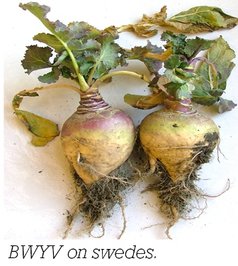Viruses
The three main brassica viruses are turnip yellows virus (TuYV), formerly beet western yellows virus; cauliflower mosaic virus (CaMV) and turnip mosaic virus (TuMV). All are common in brassica crops throughout NZ.
Identification
TuYV is characterised by colouring in the leaves, especially purples and reds, which eventually turn yellow. CaMV and TuMV cause similar symptoms to each other (tests are often required to differentiate). Infected plants show patterns, distortion and mottling in the leaves. They are stunted and often die if infection occurs early.

Importance
Early infection with any of these viruses can cause severe crop losses.
Spread
All are introduced into crops by aphids. The two main aphid species in brassicas, the green peach and grey cabbage aphid, are their main vectors. The main primary sources of these viruses are weeds and brassica volunteers in the vicinity of the crop.
Prevention and management
Good aphid control is necessary to limit viruses. Seed beds should also be kept free of host weeds and volunteers, such as wild turnip. Seed treatments such as AGRICOTE Brassica can give seedlings up to 6 weeks protection, often long enough to cover the critical period when aphids are flying. Aphicides can be used, but correct timing is hard to achieve.

